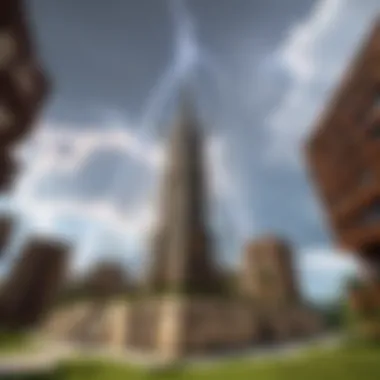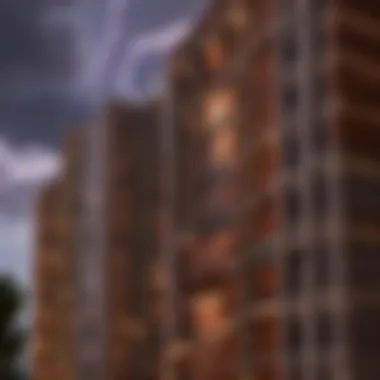Unveiling the Essential Role of Lightning Rods in Contemporary Architecture


In modern architecture, the role of lightning rods is pivotal. These essential components serve a crucial purpose in protecting buildings from the potentially catastrophic impact of lightning strikes. By offering a secure pathway for the electrical discharge to reach the ground safely, lightning rods effectively mitigate the destructive forces of lightning strikes. Architects, engineers, and building owners must grasp the intrinsic functionality and design principles of lightning rods to uphold the safety and structural soundness of the buildings they oversee.
Introduction
In the realm of modern architecture, the significance of lightning rods cannot be overstated. These unassuming yet vital components play a crucial role in safeguarding buildings from the potentially catastrophic effects of lightning strikes. Architects, engineers, and building owners must grasp the intricacies of lightning rods to ensure the safety and structural integrity of their constructions.
Defining Lightning Rods
The historical context of lightning rods
The historical context of lightning rods traces back to the groundbreaking work of Benjamin Franklin in the 18th century. His invention of the lightning rod revolutionized the concept of lightning protection, introducing a method to safely attract and redirect electrical discharges away from structures. The key characteristic of this historical context lies in its pioneering nature, offering a proactive solution to a previously uncontrollable force of nature. While advantageous in providing a systematic approach to lightning safety, the historical context of lightning rods also necessitates adaptation to modern architectural needs and technological advancements.
The basic components of a lightning rod system
Comprehending the basic components of a lightning rod system is essential in grasping its operational essence. Consisting of the rod itself, conductor cables, and grounding system, these components work cohesively to create a path of least resistance for lightning to follow. The pivotal characteristic of these components is their ability to effectively channel electrical currents towards the ground, thereby preventing potential damage to structures. While serving as a dependable method for lightning protection, the basic components of a lightning rod system require periodic maintenance and adherence to installation protocols to ensure optimal functionality.
Significance of Lightning Rods
Preventing damage from lightning strikes
The primary role of lightning rods in modern architecture lies in their capability to prevent structural damage caused by lightning strikes. By acting as a lightning attractor and conductor, these rods divert electrical currents harmlessly into the ground, mitigating the risk of fire, destruction, or fragmentation in buildings. Their key characteristic of discharging excess energy responsibly demonstrates their crucial function in preserving the structural integrity of architectural entities. However, maintaining these systems is imperative to counter any potential shortcomings in their protective capacity and uphold their efficacy.
Ensuring safety for inhabitants


Ensuring the safety of inhabitants within a structure is another pivotal aspect of lightning rod deployment. By providing a designated path for lightning discharges, these systems protect individuals from direct and indirect electrical hazards posed by lightning strikes. The key characteristic of enhancing occupant safety through controlled current dispersion underscores the indispensable nature of lightning rods in fostering secure living and working environments. Yet, continuous evaluation and adherence to safety standards are fundamental to guaranteeing the unwavering protection afforded by these systems.
Protecting electronic equipment
In addition to safeguarding structures and occupants, lightning rods also play a crucial role in shielding electronic equipment from the detrimental effects of lightning-induced power surges. By diverting electrical currents away from sensitive devices and circuits, these systems prevent potential malfunctions, data loss, or hardware damage. The standout feature of safeguarding electronic equipment underscores their relevance in the digital age, where advanced technology permeates everyday life. Despite such advantages, meticulous attention to system integration and regular maintenance are imperative to uphold the prolonged functionality of lightning rods in safeguarding electronic infrastructure.
Functionality of Lightning Rods
Lightning rods are pivotal in modern architecture, serving as a safeguard against the devastating impact of lightning strikes. Their function lies in providing a secure pathway for electrical discharge to Earth, ensuring the protection of buildings and their occupants. Engineers, architects, and building owners must grasp the intricate details of how lightning rods operate to guarantee structural integrity and safety. The significance of functionality of lightning rods encompasses elements such as their ability to redirect lightning strikes, prevent fire hazards, and mitigate damage to electronic systems within buildings.
Understanding the Physics
The role of a lightning rod in attracting lightning
The core premise of a lightning rod is its function in attracting lightning strikes towards it. This phenomenon is crucial as it directs the high voltage currents away from the building, reducing the risk of structural harm. Being a popular choice for lightning protection systems, the ability of a lightning rod to attract and dissipate lightning strikes ensures the safety of the building and its occupants. While the attraction of lightning towards a structure might seem hazardous, in the case of a lightning rod, it is a beneficial tactic that diverts the energy harmlessly into the ground, preventing potential damage.
Channeling electrical currents safely
Channeling electrical currents safely is a fundamental aspect of lightning rods' functionality. By providing a designated path for the lightning to follow, the rod ensures that the electrical current disperses harmlessly into the ground. This controlled dissipation helps in averting electrical fires, equipment damage, and harm to individuals within the building. The unique feature of securely channeling electrical currents lies in its ability to neutralize the potentially destructive force of lightning strikes, maintaining the safety and integrity of the structure.
Installation and Placement
Factors to consider when installing lightning rods


When installing lightning rods, several critical factors come into play to maximize their effectiveness. The angle and height of the rods, the quality of materials used, and the connection to the building's grounding system are paramount considerations. Ensuring proper installation is essential for the lightning rod system to function optimally, protecting the building from lightning-related damage.
Ideal locations for lightning rod placement
Selecting ideal locations for lightning rod placement necessitates a strategic approach. High points on the building, areas prone to lightning activity, and regions where the structure would be most vulnerable in a lightning strike should be targeted for rod placement. The unique feature of identifying optimal locations lies in preemptively safeguarding the building against potential lightning strikes, enhancing its overall resilience.
Design Considerations
In the realm of modern architecture, lightning rods stand out as crucial components ensuring the safety and structural integrity of buildings against the destructive power of lightning strikes. When delving into the design considerations associated with lightning rods, a meticulous approach becomes imperative. Architects and engineers must carefully weigh various elements to seamlessly integrate these protective measures into their architectural designs while maintaining a balance between aesthetics and functionality. This process extends beyond mere functionality, delving into the art of harmonizing safety features with the overall visual appeal of a structure.
Aesthetics vs. Functionality
Integrating lightning rods into architectural design
Integrating lightning rods into architectural design is a nuanced process that requires meticulous attention to detail. By seamlessly incorporating these essential safety features into the building's aesthetics, architects can elevate the overall visual appeal while ensuring optimal protection against lightning strikes. The key characteristic of integrating lightning rods lies in their ability to blend seamlessly with diverse architectural styles, seamlessly merging form and function. This approach not only enhances the structure's safety features but also adds a unique architectural element that speaks to the fusion of practicality and design innovation.
Balancing aesthetic appeal with safety features
Balancing aesthetic appeal with safety features is a delicate art that necessitates a thoughtful approach. Striking the perfect equilibrium between visual allure and protective functionality involves strategic planning and innovative design solutions. The inherent challenge lies in concealing the utilitarian aspects of lightning rods within the broader architectural scheme while maintaining their critical role in safeguarding the structure. Architects must navigate this fine line adeptly, leveraging the dual benefits of aesthetic enhancement and structural fortification to create truly sophisticated architectural compositions.
Materials and Durability
Common materials used in lightning rods


The selection of materials for lightning rods plays a pivotal role in ensuring their efficacy and longevity. Common materials such as copper, aluminum, and stainless steel are frequently employed due to their robustness and electrical conductivity. The key characteristic of these materials lies in their ability to withstand harsh environmental conditions while efficiently conducting electrical current. Their popularity stems from a combination of durability and reliability, making them ideal choices for architects seeking to enhance building safety.
Factors affecting the longevity of lightning rod systems
Maintaining the longevity of lightning rod systems necessitates a thorough understanding of the factors that influence their effectiveness over time. Elements such as environmental exposure, installation quality, and material degradation can impact the overall durability of the system. By addressing these factors proactively through regular maintenance and strategic upgrades, architects can ensure the sustained functionality of lightning rods, thereby securing the structural integrity of the buildings they protect.
Maintenance and Inspection
Maintenance and Inspection in modern architecture hold immense significance, particularly concerning lightning rods. It is crucial to regularly inspect and maintain these systems to ensure they function effectively. By adhering to strict maintenance protocols, building owners can mitigate potential risks associated with lightning strikes. Regular inspections play a pivotal role in upholding the structural integrity and safety of buildings. Through routine maintenance, possible defects or wear and tear in lightning rod systems can be identified and rectified promptly, thus preventing costly damage or hazards.
Ensuring Effectiveness
Regular Inspection Protocols
Regular inspection protocols are fundamental in guaranteeing the efficacy of lightning rod systems within modern architecture. These protocols involve thorough examinations of the lightning rods to assess their condition and functionality. They typically include visual inspections, testing of grounding systems, and verification of connections. Complying with a consistent inspection schedule ensures that any issues or malfunctions are detected early, allowing for immediate intervention and upkeep. This proactive approach to regular inspections contributes significantly to maintaining the overall safety and reliability of lightning protection systems.
Repair and Maintenance Best Practices
When it comes to ensuring the effectiveness of lightning rod systems, adhering to repair and maintenance best practices is paramount. These practices entail timely repairs of damaged components, replacement of worn-out parts, and general upkeep of the entire system. Utilizing high-quality materials for repairs and maintenance prolongs the longevity of lightning rods and enhances their functionality. Moreover, following manufacturer guidelines and industry standards for maintenance ensures the optimal performance of the lightning protection system. By embracing sound repair and maintenance practices, building owners can rest assured that their structures are well-protected against lightning-related incidents, facilitating a secure environment for inhabitants and electronic equipment.
Conclusion
Implications for Modern Architecture
The Ongoing Relevance of Lightning Rods in Contemporary Buildings
Discussing the ongoing relevance of lightning rods in contemporary buildings sheds light on the enduring importance of these systems in modern architecture. The key characteristic of lightning rods lies in their ability to act as a defense mechanism against lightning strikes. This feature is paramount in preserving the integrity of buildings and ensuring the safety of occupants. The unique advantage of incorporating lightning rods in contemporary constructions lies in their proven track record of effectively mitigating the risks associated with lightning strikes.
Embracing Technology for Enhanced Lightning Protection
Exploring the integration of technology for enhanced lightning protection underscores the innovative strides being made in modern architectural practices. The key characteristic of this approach is the use of advanced solutions to fortify traditional lightning rod systems. This technological enhancement presents a myriad of benefits, including increased efficiency in lightning strike prevention and improved safety measures for buildings. The unique feature of embracing technology lies in its capacity to adapt and evolve, offering continuous enhancements to lightning protection measures in modern architecture.



